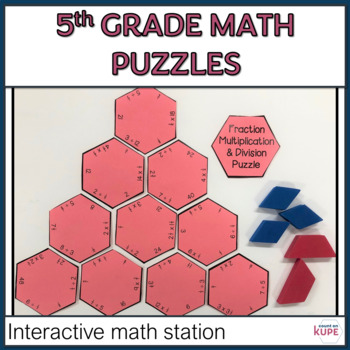5th Grade Puzzle Math Station with interactive pieces
- PDF
What educators are saying
Description
Do you want to add puzzles to your math workshop? These hexagons are a perfect addition to any math class. Students match a math expression to its solution in order to piece the puzzle together. The puzzles fit together to make a pyramid. I like to use the puzzles as a station in my math workshop or a done early activity. The goal of the puzzles is to help students review different 5th math computation. I added a modified version of the puzzle where there are no extra expressions.
Included in this Download:
-Hexagon puzzles
-Modified Hexagon puzzles
-Hexagon puzzle worksheet
-Each page is formatted as an Answer Key
Try one for FREE here:
All the puzzles that are included:
(2 versions of each)
-Hexagon Puzzle Worksheet
-Order of Operations
-Multiplication Facts
-Double Digit Multiplication
-Single Digit Divisor Division
-Double Digit Divisor Division
-Multiplication and Division
-Decimal Addition
-Decimal Subtraction
-Decimal Addition and Subtraction
-Decimal Multiplication
-Decimal Division
-Decimal Multiplication and Division
-Fraction Addition
-Fraction Subtraction
-Fraction Addition and Subtraction
-Fraction Multiplication
-Fraction Division
-Fraction Multiplication and Division
-Convert Measurement – Customary
-Convert Measurement – Metric
Other products you might like:
- Math Reference Bulletin Board (with hexagons!)
- Math Hanging Calendars for Middle School
- Math Affirmation Bulletin Board
Are you using one of my products? Post one on Instagram and tag me @countonkupe so I can share!
If you would like to see my products in action, check out my website COUNT ON KUPE. Questions? Email me at annette@countonkupe.com
** How to get TPT credit to use on future purchases **
Go to your My Purchases page. Beside each purchase, you will see a “Provide Feedback” button. Click it and give a rating and leave a comment! You will have credits to use on future purchases.
** Be the first to hear about my new products and discounts! **
Click HERE to become a follower. You will then see my updates!
Let me know what you think!
Happy Teaching!





